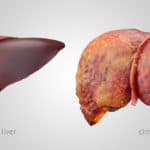Increased Cancer Risk With HCV
The following report seems scary at first. A significantly higher incidence of two serious types of cancer in Hepatitis C patients is certainly important. But, the normal incidence of non-hodgkin’s lymphoma is just 12 cases per 100,000 worldwide in 2001. So, with double the incidence that would be just 24 cases per 100,000 Hepatitis C patients. Not exactly a widespread or common situation.
It is very important to keep reports like these in perspective.
Normal multiple myeloma incidence is approximately 6 cases per 100,000 population in the US. So, 2.5 times that, is just 15 cases per 100,000 Hepatitis C patients.
Cancer in patients with hepatitis C
24 Feb 2005
People infected with the hepatitis C virus (HCV) have a higher risk of developing non-Hodgkin’s lymphoma and multiple myeloma, according to a recent study of the Swedish population. These findings are published in the March 2005 issue of Hepatology, the official journal of the American Association for the Study of Liver Diseases (AASLD). Published by John Wiley & Sons, Inc, the journal is available online via Wiley InterScience: http://www.interscience.wiley.com/journal/hepatology.
Previous studies have shown that people with HCV have a higher risk of developing cirrhosis and liver cancer, however, studies of the association between HCV and other malignancies have yielded varied and conflicting results. In Sweden, a cluster of four cases of non-Hodgkin’s lymphoma in 554 HCV patients raised the question of an association between those two diseases and other related cancers in the country’s population.
To evaluate this possibility, researchers, led by Ann-Sofi Duberg of Örebro University Hospital in Sweden, gathered data from the Swedish Institute for Infectious Disease Control and the Swedish Cancer Registry to examine the incidence of non-Hodgkin’s lymphoma, multiple myeloma, chronic lymphatic leukemia, acute lymphatic leukemia, Hodgkin’s lymphoma and thyroid cancer in the country’s entire cohort of HCV patients.
For 27,150 HCV patients, the researchers modelled the date of HCV infection based on age and mode of transmission. They then collected data on the relevant cancer diagnoses among these patients for the time period from 1990 to 2000, excluding those whose HCV diagnosis was within 3 months of their cancer diagnosis. Lastly, they performed statistical analyses to compare these patients’ cancer rates to those of the entire Swedish population.
They found that the risk of both non-Hodgkin’s lymphoma and multiple myeloma were significantly higher compared to the general population – 1.99 and 2.54 times higher, respectively. Their risk of chronic lymphatic leukemia and thyroid cancer were not significantly higher, and the incidence of both acute lymphatic leukemia and Hodgkin’s lymphoma was too low to be included.
“The majority of the non-Hodgkin’s lymphoma and multiple myeloma patients were estimated to have been infected more than 15 years, which is consistent with the theory that lymphomagenesis is a slow process and non-Hodgkin’s lymphoma develops after a long influence,” say the authors. They suggest that the risk for HCV-related malignancy increases with time of HCV infection.
As in many countries, Sweden has had an increase in the incidence of malignant non-Hodgkin’s lymphoma in recent years. As most Swedish HCV patients were born after 1950, the cancer increase might be related to long-lasting HCV infection.
In conclusion, “this is the first study of the incidence of non-Hodgkin’s lymphoma, multiple myeloma, chronic lymphatic leukemia, acute lymphatic leukemia, Hodgkin’s lymphoma and thyroid cancer in a nationwide cohort of HCV-infected persons,” the authors report. “Although the delayed diagnosis of hepatitis C most probably has made us underestimate the risk, this study showed that the risk of B-cell non-Hodgkin’s lymphoma and multiple myeloma were significantly increased.”
——————–
Article: “Non-Hodgkin’s Lymphoma and Other Nonhepatic Malignancies in Swedish Patients With Hepatitis C Virus Infection,” Ann-Sofi Duberg, Marie Nordström, Anna Törner, Olle Reichard, Reinhild Strauss, Ragnhild Janzon, Erik Bäck, and Karl Ekdahl, Hepatology; 41:3; March 2005 (DOI: 10.1002/hep.20608).







